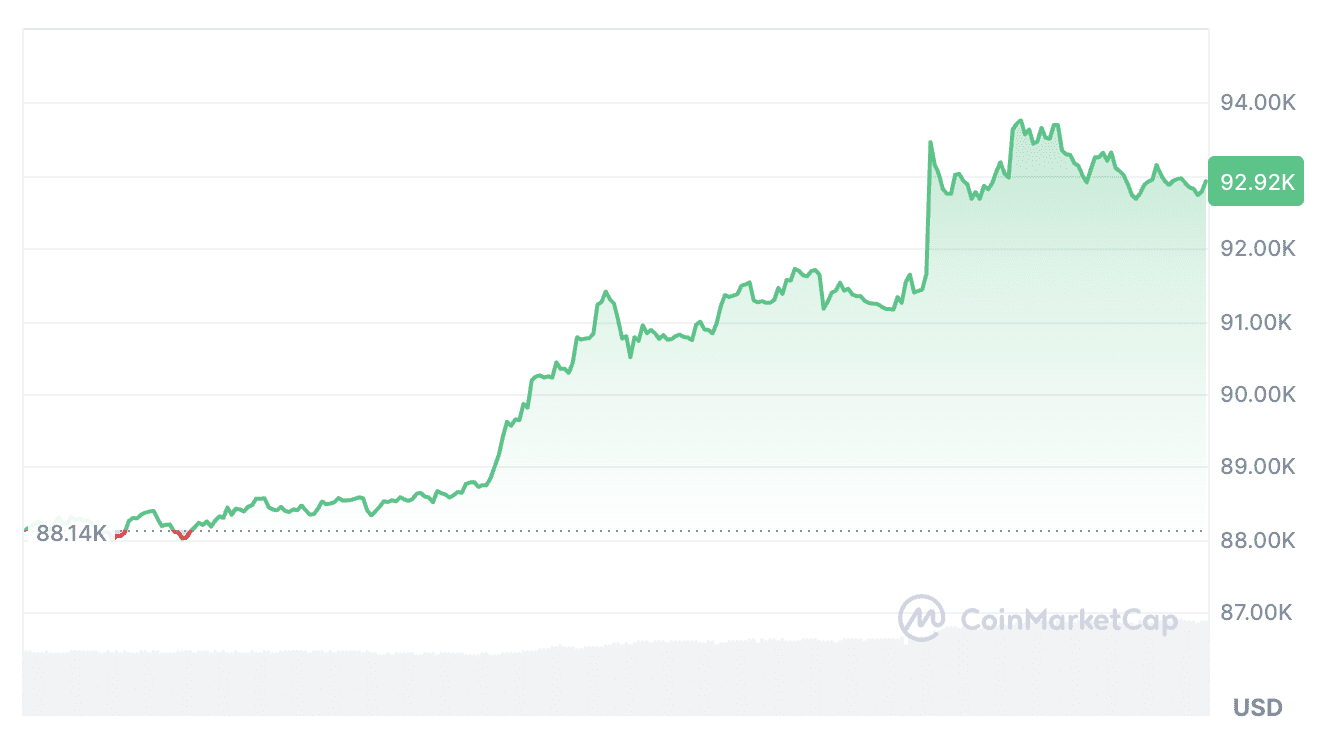Bitcoin has surged past $93,000, reaching its highest level in seven weeks. This rally, building on momentum from the Easter weekend, is attributed to a combination of factors, including a shift in Donald Trump’s rhetoric on trade and continued growth in Bitcoin ETF investments.
Key Drivers of the Bitcoin Price Surge:
- Trump’s Trade War Stance: President Trump indicated a potential softening of his stance on trade tariffs with China, which has been interpreted as a bullish signal for the market.
- Bitcoin ETF Inflows: Spot Bitcoin ETFs in the U.S. experienced significant inflows, demonstrating increasing investor confidence.
- Improved Market Sentiment: Overall sentiment in the cryptocurrency market has improved, contributing to the positive price action.
Traders are closely watching Bitcoin’s price movements, with some describing the recent surge as the “craziest one-minute candle” they’ve seen. Analysts are speculating about the potential for further upside, with some suggesting Bitcoin could soon test the $100,000 level.

Expert Opinions:
Crypto commentator Ted suggested that Bitcoin will ‘catch up’ with gold and reach the $100,000 price level. Economist Alex Kruger stated, “Trump just ticked most de-escalation/bullish boxes.” Investing with Brandon also echoed this sentiment, describing the news as ‘bullish’.
Broader Market Context:
The positive trend in Bitcoin is mirrored in traditional financial markets, with the S&P 500, Nasdaq, and Dow Jones all showing gains on the same day. This suggests a broader improvement in investor confidence across various asset classes.
Factors Influencing Bitcoin’s Price: A Deeper Dive
To understand the current rally, it’s essential to examine the core elements at play. These range from macroeconomic factors to technical analysis and market sentiment.
1. Macroeconomic Indicators and Geopolitical Events
Macroeconomic conditions play a crucial role in shaping Bitcoin’s price. Factors such as inflation, interest rates, and global economic growth can all influence investor behavior. In this instance, Trump’s stance on trade, typically a source of market uncertainty, seemingly created a bullish reaction when he softened his approach. Geopolitical stability and the overall health of the global economy can further affect investor appetite for risk assets like Bitcoin.
2. Institutional Adoption and ETF Performance
The introduction and performance of Bitcoin ETFs have been a game-changer. These ETFs provide traditional investors with a regulated and easily accessible way to gain exposure to Bitcoin. Positive inflows into these ETFs indicate growing institutional adoption, which translates to increased demand and, ultimately, price appreciation.
3. Technical Analysis and Market Sentiment
Technical analysts study price charts and patterns to predict future movements. Breakouts above key resistance levels, such as the $93,000 mark, are often seen as bullish signals. Market sentiment, driven by news, social media, and investor psychology, can also drive short-term price fluctuations. A positive feedback loop can emerge when rising prices attract more buyers, further fueling the rally.
4. Regulatory Landscape
Regulatory developments, both positive and negative, can have a significant impact on Bitcoin. Clear and supportive regulations can foster greater institutional participation and mainstream adoption. Conversely, restrictive regulations can dampen enthusiasm and hinder growth.
Potential Risks and Considerations
While the current outlook for Bitcoin appears positive, it’s crucial to acknowledge the inherent risks associated with cryptocurrency investments. Market volatility is a constant concern, and prices can fluctuate wildly in short periods. Regulatory uncertainty and potential security breaches also pose ongoing threats.
The Future of Bitcoin: Predictions and Expectations
The future trajectory of Bitcoin remains a subject of much debate and speculation. Optimists point to its potential as a hedge against inflation, a store of value, and a decentralized alternative to traditional financial systems. Skeptics raise concerns about its environmental impact, scalability limitations, and potential for illicit activities. However, innovation is consistently implemented to combat those issues.
Ultimately, the long-term success of Bitcoin will depend on its ability to address these challenges, foster wider adoption, and navigate the evolving regulatory landscape. The recent price surge is undoubtedly a positive sign, but it’s essential to approach Bitcoin investments with caution, conduct thorough research, and be prepared for the inherent risks involved.